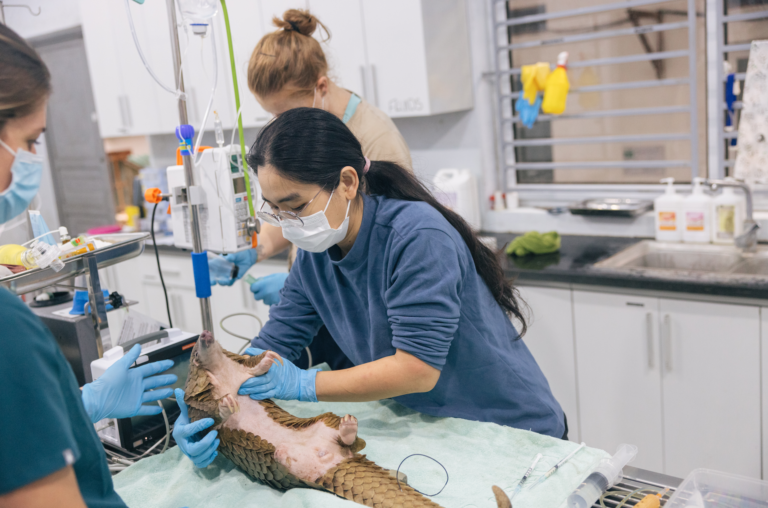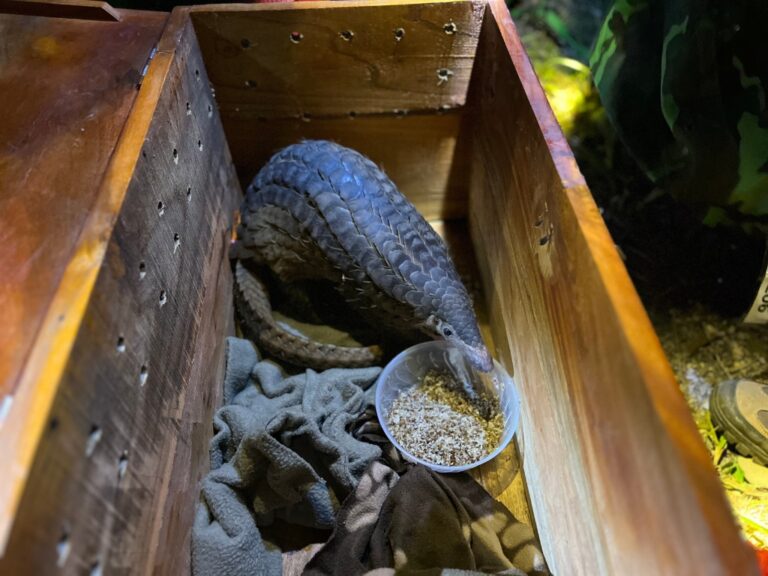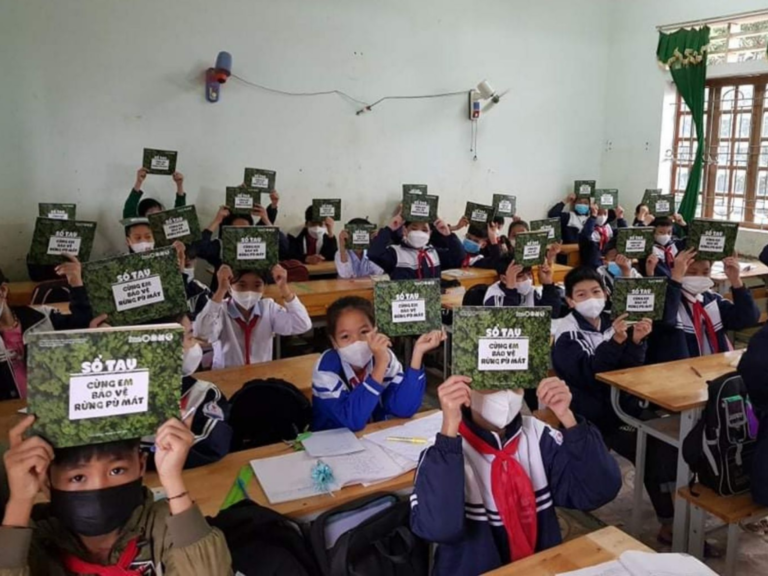In the history of Vietnamese Culture, the Indochinese Tiger (Panthera tigris corbetti) has become a symbol that is strongly associated with daily life. Not only is the tiger one of the 12 Vietnamese zodiac animals, but it has also become a popular motif in different decorative arts and sculptures throughout many periods in the country’s history, including tiger symbols carved on the Dong Son drums, tiger stone statues of the Tran dynasty, ceramic tiger of the Le dynasty, and the tiger design on the Nine Tripod Cauldrons under the Nguyen dynasty.
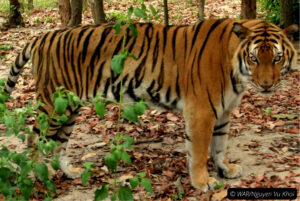
An Indochinese Tiger – © WAR/Nguyễn Vũ Khôi
In addition, the images of tigers appear in Vietnamese daily life, through a great variety of art forms and artistic expressions. The tiger is one of the main subjects in many Vietnamese paintings, with the Five Tigers painting of Hang Trong as an outstanding example. The Five Tigers painting hanging on walls will tell us that the owner is Vietnamese without having to ask.
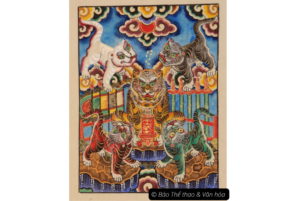
Tigers in Vietnamese art – © The thao & Van hoa (Sport & Culture) Newspaper
Furthermore, in the common literature treasures of Vietnamese people, there is a lot of proverbs and idioms about tigers, with many of them being extremely common in daily conservation and widely used in newspapers, examples of this is “Ho du chang no an thit con”, (Although being aggressive, tigers can not bear to eat their own cubs), or “Ho phu sinh ho tu” (a cub’s characteristics resemble their tiger parents’ good characteristics). The tiger also plays a central role in many fairy tales and fables that have been passed down from generation to generation. Many Vietnamese, it seems, have learnt literary works with inspiration from tigers, such as the poem Nho rung (Missing the Jungle) by The Lu.
Although the Indochinese Tiger is a potent symbol and has such a close relationship with the cultural life of the Vietnamese, tiger populations in the wild have been in a serious decline. According to Vietnam’s Red Data Book, the Indochinese Tiger is listed as a Critically Endangered species. One of the main reasons for this is the continual destruction of habitat. At a national conference on the management of systems of special-use forest zones and forest protection and development through 2020, it was noted that primary forest coverage has shrunk to 0.25 percent in Vietnam (VNExpress, 2020). While tigers are solitary, territorial animals, they need large contiguous areas of habitat. Each of them need a home range generally between 200 and 1000 square kilometers for their survival (ThoughtCo, 2019). Habitat loss and depletion of food have caused wild animals to lose their instincts and affect their reproduction, which add to the tiger’s risk of extinction.
Illegal tiger poaching and trafficking, to fuel demands for tiger products, are the most immediate threats, which are pushing tigers toward extinction. Between 2004 and 2019, Viet Nam was involved in more than 600 seizures linked to illegal poaching, which includes skins, bones, and other products sourced from at least 228 tigers (EIA, 2019). Illegal tiger trading is still a cause for concern, even though it is banned by law. According to TRAFFIC (2019), in just one month, from 27th March to 28th April 2018, there were 187 online advertisements offering tiger products on social media and eCommerce sites. Clearly, illegal tiger poaching, trafficking, and consumption are pushing tigers further to the edge of extinction.
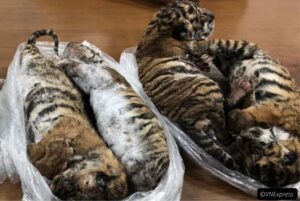
Frozen tigers carcasses from illegal seizure – © The thao & Van hoa (Sport & Culture) Newspaper
Today, although natural forest areas have been protected, as well as improvements to local law enforcement and awareness raising, the Indochinese Tiger, a thousand-year cultural symbol, an integral part of Vietnamese daily life, has almost disappeared from forests, causing a huge cultural loss for every Vietnamese person. In order to protect tigers, as well as preserve a familiar and close cultural symbol in the lives of Vietnamese people, action needs to be taken to stop illegal tiger poaching, trading, and consumption.
Scientifically tigers are important for human survival. According to WWF India (n.d), if tigers become extinct, the entire system would collapse. Without tigers, there will be a rapid increase in herbivore populations, which will completely overwhelm the vegetation of the ecosystem due to overgrazing. Seeds and young trees will be consumed and destroyed by extensive herbivore populations, which prevents forest growth and reduces vegetation cover. Loss of vegetation cover will lead to an increase in soil erosion and cause forest degradation in the longer term. With the degradation and loss of forests, we lose the system that provides essential services such as clean air and water, and we also lose the natural barrier protecting us from flood and drought. Evidently, tigers play an important role in preserving the ecosystem and the earth we live in. This alone can ensure that we should protect tigers, which in turn will protect our lives on this planet.
Today, tiger populations in Vietnam and around the world have declined at an alarming rate. According to a report of the International Union for Conservation of Nature (IUCN) in 2021, there were around 100,000 tigers in 1900. In 2014, the numbers of tigers decreased by 90% with only 3,500 tigers in the wild. The year 1997 marks the last time Indochinese tigers were photographed in Vietnam by camera trap (Lynam, 2010). A report of World Wildlife Fund (Indenbaum, 2018) shows that there are no more than 5 tigers living in the wild in Vietnam by 2016. All those numbers are telling us, the Vietnamese, that we can no longer ignore the practices of illegal poaching, trafficking and consumption, and we need to take serious actions to protect Indochinese Tigers.
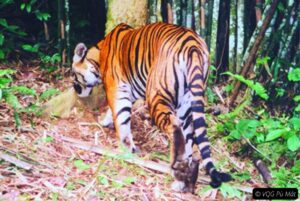
An Indochinese Tiger recorded in a national park in Vietnam by camera traps – © Pu Mat NP
Even though tigers are on the edge of extinction, there are still opportunities to take action to preserve tigers. Stuart Chapman, the leader of the Tigers Alive Initiative of WWF, claimed that by protecting the natural habitats, preventing illegal poaching, reducing demands of tiger products and engaging local communities in tiger conservation, the tiger population can recover (as cited in WWF, 2021). In 2009, more than 2,000 Indian students took part in a parade in New Delhi in an effort to highlight the need for the governments and Indian people to save tigers; these efforts have resulted in a growth of the tiger populations in that country. Particularly, in India and Nepal, the population of tigers in the wild has doubled since 2006 (WWF, 2020). Evidently, there is still hope for the Vietnamese to recover the Indochinese Tiger populations. With determination and urgent action, we, the Vietnamese, can help to bring the tigers back from the edge of extinction.
As a Vietnamese person, we can join hands to save tigers. To reduce demand for tigers, we should not consume tiger meat, tiger bone glue and other tiger products, and encourage our families and friends to stop purchasing and consuming tiger products. Only when there is no demand for tiger products, will Indochinese Tigers be safe from poaching.
Besides, by reporting any violations about illegal wildlife products, we are contributing to the prevention of illegal poaching, trafficking, trading, advertising, and consumption of wildlife. In Vietnam, tigers are on the list of endangered, precious and rare species prioritized for protection (According to Decree 64/2019/ND-CP dated July 17, 2019) and belong to the group IB – the list of endangered species of forest animals that are strictly prohibited from exploitation and use for commercial purposes (According to Decree 84/2021/ND-CP dated September 22, 2021). Keeping silent on this topic is enabling wildlife violations to occur. If you see or hear any suspected wildlife violations, please report it by going to the official website https://tuchoithitdongvathoangda.com and fill the Wildlife Violations Reporting form, or call the hotline 18001522 of Education for Nature Vietnam (ENV).
Today there are many organisations in Vietnam and around the world that are working tirelessly to stop tigers disappearing from this earth. Amongst those organisations, Save Vietnam’s Wildlife (SVW), has been working with conservation agencies and local authorities to strengthen law enforcement, in order to crack down on the illegal tiger poaching, trading and trafficking. At the same time, SVW promotes conservation research, habitat protection, public awareness-raising, and behavioral change campaigns to reduce the demand for wildlife products to protect wildlife in general and the Indochinese Tiger in particular.
Everyone can support their activities by helping to spread the message “Saying No to Wildlife products” or make a donation to SVW and other conservation organizations. No effort is too small, that if we act together, we can completely stop illegal tiger hunting, trading,transportation, storage, and consumption, so the tiger population in the wild can recover.
With the year of the tiger upon us, we should welcome 2022 with the tiger’s strength and determination. Let’s act together to protect tigers, a thousand-year cultural symbol and a vital factor in our ecosystem, so we can live in the same world with Indochinese Tigers.
Tài liệu tham khảo / References:
VNExpress. (2020). Primary forest coverage shrinks to 0.25 percent in Vietnam. VNExpress. https://e.vnexpress.net/news/news/primary-forest-coverage-shrinks-to-0-25-percent-in-vietnam-4191696.html
ThoughtCo. (2019). Tiger Facts: Habitat, Behavior, Diet. ThoughtCo. https://www.thoughtco.com/what-is-a-tiger-129743
EIA. (2019). Running out of time: Wildlife Crime Justice Failures in Vietnam. EIA. https://eia-international.org/wp-content/uploads/EIA-report-Running-out-of-Time.pdf
TRAFFIC. (2019). TIGER PRODUCT CONSUMERS Suggested demand reduction messaging. TRAFFIC. https://www.traffic.org/site/assets/files/12254/tiger-product-consumers-web.pdf
WWFIndia. (n.d). Why should we save tigers?. WWFIndia. https://www.wwfindia.org/about_wwf/priority_species/bengal_tiger/why_save_the_tigers/
IUCN. (2021). Impact results from projects implemented between 2015 and 2021 – INTEGRATED TIGER HABITAT CONSERVATION PROGRAMME. IUCN. https://iucnsos.org/wp-content/uploads/2021/09/ITHCP-Phase-I-Impact-Report-updated-09.2021.pdf
Lynam, A. J. (2010). Securing a future for wild Indochinese tigers: Transforming tiger vacuums into tiger source sites. Integrative Zoology, 5(4), 324-334. http://dx.doi.org/ 10.1111/j.1749-4877.2010.00220.x
Indenbaum, R. (2018). A rapid assessment of the Tiger Trade in Viet Nam. TRAFFIC. https://www.traffic.org/site/assets/files/10567/bulletin-30_1-tiger-assessment-vietnam.pdf
WWF. (2021). Global Tiger Day marks uneven progress towards the global goal to double wild tigers by 2022. WWF. https://tigers.panda.org/?4161941/Global-Tiger-Day-Southeast-Asia-progress-goal-double-wild-tigers
WWF. (2020). Global Tiger Day marks mixed progress 10 years after governments commit to doubling wild tigers. WWF. https://wwf.panda.org/wwf_news/?364750/Global-Tiger-Day-2020

